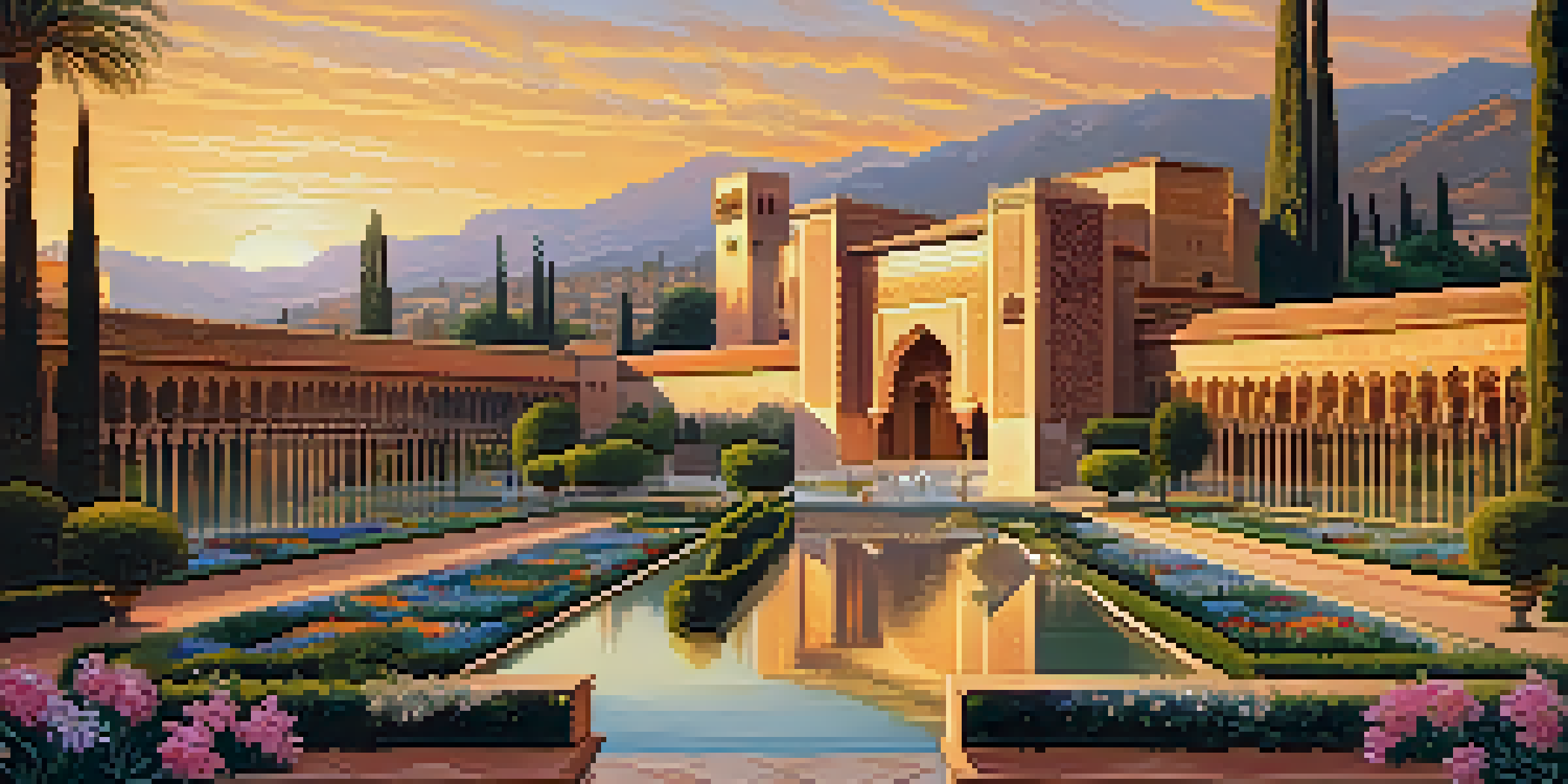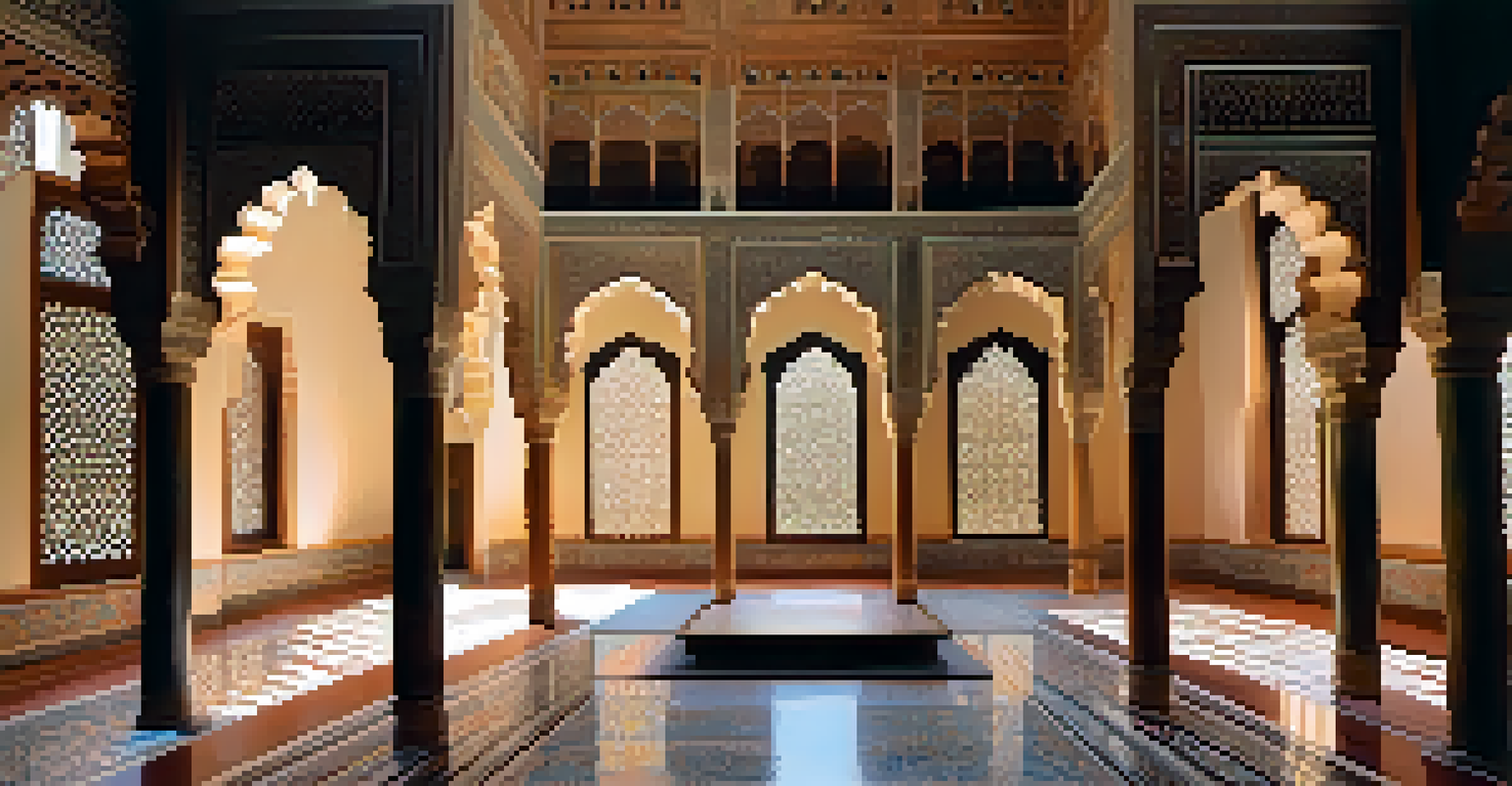The Alhambra: A Cinematic Jewel in Granada's History

The Alhambra: A Glimpse into Moorish Architecture
The Alhambra is a stunning example of Moorish architecture, showcasing intricate designs and artistic flair that captivate visitors. Built in the mid-13th century, this palace and fortress complex reflects a blend of Islamic art and Spanish culture. The delicate arches, ornate tile work, and lush gardens create an enchanting atmosphere that feels like stepping into a fairytale.
The Alhambra is a wonderful example of the beauty that can arise from the fusion of cultures.
One of the most remarkable features of the Alhambra is the Nasrid Palaces, where visitors can admire intricate stucco work and elaborate ceilings. Each room tells a story, with its unique designs symbolizing different aspects of life and faith. The famous Court of the Lions, with its iconic fountain surrounded by twelve marble lions, is a prime example of this exquisite craftsmanship.
As you wander through the Alhambra, you can't help but feel a connection to the past. The architecture not only represents a historical period but also serves as a canvas for the dreams and aspirations of those who once inhabited this magnificent space.
The Alhambra's Role in Spanish Cinema
The Alhambra has inspired countless filmmakers and artists over the years, serving as a backdrop for numerous films and documentaries. Its breathtaking beauty and historical significance make it a natural choice for storytelling, drawing audiences into the rich tapestry of Granada's past. From romantic dramas to historical epics, the Alhambra has played a pivotal role in shaping cinematic narratives.

Films like 'The Man Who Knew Too Much' and 'The Last Crusade' feature the Alhambra, using its majestic presence to enhance the story's emotional depth. The stunning visuals captured on screen transport viewers to a world where history and fiction intertwine. These cinematic portrayals not only showcase the Alhambra's allure but also spark curiosity about its history.
Moorish Architecture's Masterpiece
The Alhambra exemplifies Moorish architecture, blending Islamic art and Spanish culture through intricate designs and lush gardens.
Moreover, the Alhambra's appearances in film have boosted tourism, inviting travelers from around the globe to experience its magic firsthand. As people flock to Granada, they seek to walk the same halls and gaze upon the same views that have captivated filmmakers and audiences alike.
Cultural Significance of the Alhambra
Beyond its architectural beauty and cinematic appeal, the Alhambra holds deep cultural significance for Spain and the world. It symbolizes the coexistence of different cultures, particularly during the time of Muslim rule in Spain. The blending of Islamic, Christian, and Jewish influences is evident throughout the complex, highlighting a rich history of tolerance and collaboration.
In every corner of the Alhambra, there is a story waiting to be told.
The Alhambra has also inspired writers, poets, and artists, serving as a muse for countless works. Renowned figures like Washington Irving have penned tales that romanticize its beauty, further embedding the Alhambra into the fabric of literary culture. These stories often highlight themes of nostalgia, love, and loss, making the Alhambra a symbol of longing and beauty.
In addition, the UNESCO World Heritage designation emphasizes the site's universal value, encouraging preservation efforts for future generations. This status helps ensure that the Alhambra continues to inspire and educate, fostering a deeper understanding of cultural heritage.
The Alhambra's Gardens: A Natural Oasis
The gardens of the Alhambra, particularly the Generalife, are a tranquil escape that complements the architectural grandeur. Designed as a serene retreat for the Nasrid rulers, these gardens feature lush greenery, fragrant flowers, and flowing water, creating a harmonious balance between nature and design. Visitors often describe the experience of strolling through these gardens as a peaceful journey through history.
The Generalife's terraced gardens, with their stunning views of the Alhambra and the Sierra Nevada mountains, provide a picturesque setting for reflection and relaxation. The carefully curated landscapes invite guests to pause and appreciate the beauty around them, much like a scene from a cinematic masterpiece. Every corner reveals a new perspective, encouraging exploration and contemplation.
Cultural Symbol of Coexistence
The Alhambra represents the historical coexistence of Islamic, Christian, and Jewish cultures, showcasing a rich tapestry of tolerance and collaboration.
Moreover, the gardens serve as a reminder of the importance of nature in the Moorish way of life. Water features and shady alcoves were designed to create a cool oasis in the hot Andalusian climate, highlighting the sophisticated understanding of landscape design. This connection to nature adds another layer of richness to the Alhambra experience.
Visiting the Alhambra: Practical Insights
Planning a visit to the Alhambra requires some foresight, as it attracts millions of tourists each year. To fully enjoy this historic site, it's advisable to book tickets in advance, especially during peak season. Guided tours can provide valuable insights, enhancing your understanding of the complex's history and architecture while ensuring you don't miss any hidden gems.
Timing your visit can also make a significant difference. Early mornings or late afternoons offer a quieter experience, allowing you to soak in the beauty without the crowds. Additionally, the soft golden light during these times creates a magical ambiance, perfect for photography enthusiasts eager to capture the Alhambra's essence.
Don't forget to explore the surrounding areas of Granada, which are equally rich in culture and history. From the vibrant streets of the Albayzín to the stunning views from the Mirador de San Nicolás, each corner of Granada offers a unique glimpse into the city's soul, rounding out your Alhambra experience.
The Alhambra: A UNESCO World Heritage Site
Designated as a UNESCO World Heritage Site in 1984, the Alhambra's significance goes far beyond its stunning appearance. This recognition highlights the importance of preserving cultural heritage sites that reflect the history and achievements of civilizations. It reminds us of our responsibility to protect such treasures for future generations.
Being part of the UNESCO family also brings attention to the ongoing conservation efforts required to maintain the Alhambra's structural and artistic integrity. This includes addressing challenges posed by tourism, weathering, and the natural environment, ensuring that the Alhambra remains a vital part of our global heritage.
UNESCO Heritage and Preservation
As a UNESCO World Heritage Site, the Alhambra highlights the importance of preserving cultural heritage for future generations.
Moreover, the designation encourages educational initiatives aimed at fostering appreciation for the Alhambra's history and architecture. Programs that engage local communities and visitors alike help keep the spirit of the Alhambra alive, inspiring a sense of pride and stewardship among those who encounter its beauty.
The Alhambra: A Lasting Legacy
The Alhambra's legacy extends far beyond its physical structure; it embodies the stories, dreams, and aspirations of those who came before us. As a symbol of cultural exchange, it serves as a reminder of the rich tapestry of human history, where different traditions and ideas converge. This legacy continues to inspire artists, writers, and filmmakers, ensuring that the Alhambra remains a source of creativity and wonder.
Today, the Alhambra stands as a beacon of artistic achievement and cultural dialogue. It encourages visitors to reflect on their own histories and the interconnectedness of cultures throughout time. The stories woven into the fabric of the Alhambra remind us of the beauty that arises from collaboration and understanding.

Ultimately, visiting the Alhambra is more than just a journey through a historic site; it’s an invitation to engage with the past and imagine the future. As we walk through its halls and gardens, we become part of its ongoing narrative, carrying the spirit of the Alhambra into the world beyond its walls.